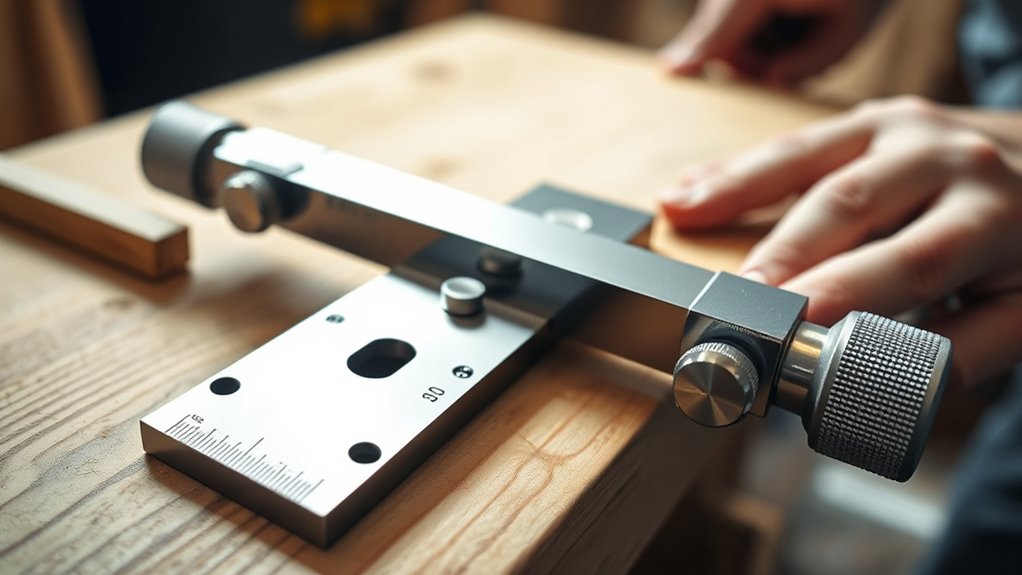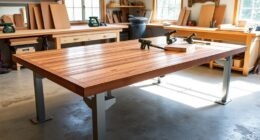A sliding T-bevel helps you accurately duplicate and transfer angles by adjusting its blade to match the desired measurement before locking it in place. Once secured, you can easily mark or transfer that angle onto your workpiece, ensuring consistent cuts and joints. This tool is perfect for complex miter cuts, irregular angles, or replicating templates. Keep exploring to discover advanced tips for using your T-bevel more effectively in your projects.
Key Takeaways
- Loosen the locking screw, then slide the blade to match the desired angle on the scale or by sight.
- Tighten the screw securely to lock the blade in place for accurate angle transfer.
- Place the T-bevel onto your workpiece and trace the blade to replicate the angle precisely.
- Use the tool to duplicate complex or custom angles across multiple projects for consistency.
- Ensure the locking mechanism is secure during transfer to maintain measurement accuracy and precision.

Have you ever needed to mark or transfer an angle accurately? If so, a sliding T-bevel is a tool that can make your work much easier. This versatile tool allows you to duplicate or transfer angles precisely, which is essential for ensuring tight fits and correct cuts. When working on projects that require measuring accuracy, especially in woodworking applications, the sliding T-bevel becomes an indispensable asset. Its adjustable blade and locking mechanism enable you to copy angles from one piece to another or transfer them onto different materials without guesswork.
Using a sliding T-bevel is straightforward, but understanding its function can considerably improve your craftsmanship. You start by loosening the locking screw, which allows you to slide the blade along the stock to match the angle you want to duplicate. Once aligned, tightening the screw secures the blade in place, ensuring that the angle won’t shift during transfer. This process guarantees that the measurements stay consistent, which is critical when you’re working on complex joints or matching angles in furniture making. The tool’s ability to hold and lock various angles with stability vastly improves measuring accuracy, reducing errors that could compromise your project.
Loosen the screw, match the angle, then tighten to secure for precise transfers.
In woodworking applications, the sliding T-bevel shines because it simplifies what can otherwise be a tedious process. Instead of using a protractor or other measuring devices, you can rely on this tool to quickly replicate angles from one component to another. For example, if you need to match a mitre cut or replicate a custom bevel, you simply set the T-bevel to the existing angle, lock it, and then transfer that angle onto your workpiece. This method ensures consistent results, saving you time and eliminating the frustration of repeated adjustments. Plus, because the tool is adjustable and portable, you can easily carry it around your workspace, making it ideal for on-the-fly measurements and adjustments.
Furthermore, the sliding T-bevel is durable and designed for precision. Its material composition ensures it withstands the rigors of workshop use, maintaining measuring accuracy over time. It’s an essential tool for carpenters, woodworkers, and DIY enthusiasts who value accuracy and efficiency. Whether you’re creating detailed moldings, fitting complex joints, or customizing furniture pieces, the sliding T-bevel provides a reliable way to duplicate and transfer angles flawlessly. Its simplicity and precision make it an invaluable addition to your toolkit, helping you achieve professional results every time. Proper care and maintenance of your measuring tools can extend their lifespan and keep your measurements accurate, which is crucial for high-quality craftsmanship. With a little practice, you’ll find it becomes second nature to use this tool for all your angle measurement and transfer needs, making your projects smoother, more accurate, and more satisfying.
Frequently Asked Questions
Can a Sliding T-Bevel Be Used for Woodworking or Metalworking?
Yes, you can use a sliding T-bevel for woodworking and metalworking. It helps with angle duplication and measurement transfer, making it easy to replicate precise angles on different pieces. You simply set the bevel to the desired angle, lock it in place, and then transfer that measurement onto your work material. This tool is versatile and essential for ensuring accurate cuts and fittings in both crafts.
What Materials Are Best for Making a Durable Sliding T-Bevel?
You should choose materials with high durability for making a sliding T-bevel, like hardened steel or brass, as they resist wear and corrosion. These materials guarantee long-lasting performance, especially under frequent use. Additionally, incorporating robust slide lock mechanisms made of metal enhances stability and prevents slipping. Avoid plastics or softer metals, as they may compromise durability and accuracy over time.
How Do I Maintain and Calibrate My Sliding T-Bevel?
Imagine your sliding T-bevel as a trusted compass guiding your cuts. To keep it accurate, regularly check the calibration techniques by measuring known angles and adjusting the locking screw as needed. Maintenance tips include cleaning it after use, avoiding knocks, and lubricating the locking mechanism. With consistent care, your T-bevel stays precise, ensuring your measurements transfer flawlessly and your projects remain spot-on.
Are There Digital or Electronic Alternatives to Traditional Sliding T-Bevels?
Yes, there are digital alternatives to traditional sliding T-bevels. Electronic tools like digital angle finders and smart protractors let you measure and duplicate angles with high precision. You simply set the device to the desired angle, and it displays the measurement digitally. These electronic tools are often more accurate and easy to read, making them a great modern upgrade for woodworking and construction projects.
Can a Sliding T-Bevel Measure Complex or Compound Angles?
A sliding T-bevel is like a versatile tool in your toolbox, but it struggles with complex or compound angles. It’s great for simple angle duplication and measurement transfer, yet when faced with intricate angles, you’ll need to measure and transfer each part carefully. For more precise results, consider combining it with a protractor or using digital tools designed for complex angle measurement.
Conclusion
A sliding T-bevel makes measuring and copying angles quick and easy, even if you’re new to woodworking. Some might think it’s too simple or unreliable, but with careful handling, it’s surprisingly accurate. Don’t worry about perfect results—practice makes perfect. Once you get the hang of it, you’ll find this tool indispensable for precise cuts and fitting. Keep experimenting, and you’ll soon wonder how you ever worked without it!









